Settler Colonialism, Families, and Racialized Thinking: Casta Painting in Latin America
Dana Leibsohn and Barbara E. Mundy
[print edition page number: 397]
The history of race and of racialized thinking took a distinctive turn when Europeans became settler colonists in the Americas after 1492. So decisive were these changes that they still inflect thinking about identity, image-making, and family histories today. Consider the digital print created in 1998 by the artist Iñigo Manglano-Ovalle. Part of a series, collectively named The Garden of Delights, the panels of the triptych each show an enlarged scan of a DNA sample (figure 1).[1] These samples came from individuals named in the image’s title: Glenn, Dario and Tyrone, all of whom made willing donations of their biomatter for Manglano-Ovalle’s project. For the purposes of this artwork, the trio chose to be grouped as a “family.” The triptych thereby riffs on the traditional idea of a family portrait: each individual appears not as they look but as “they really are” — at least in contemporary genetic terms. [398]
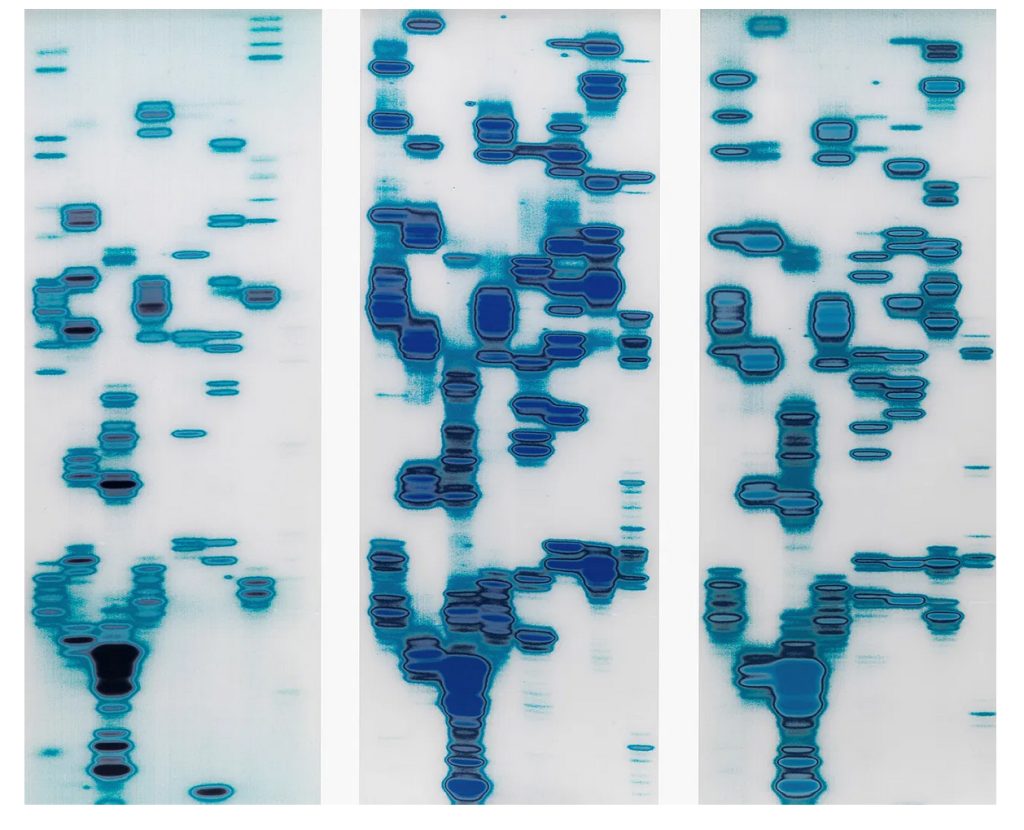
As a family portrait, Glenn, Dario and Tyrone invites deeper thinking about the persistent ideas produced by Euro-American histories of race, using some of the tools that art history offers to interpret visual works of the past and the present. On one register, the digital print references social identities and forms of belonging that individuals can choose to enact and embody. That is, they are largely performative: the title gives personal names, and the composition sets Glenn, Dario, and Tyrone alongside the others they chose as family, people whose genes they do not necessarily share. On another register, this artwork taps into conventional ideas about genetics. The use of DNA to represent Glenn, Dario, and [399] Tyrone tethers the group portrait to the hard “facts” of biology, and in this, the artwork asks its viewers to question whether aspects of identity are immutable. Since the artwork offers no mimetic imagery (that is, no images of faces or bodies), it is impossible to know how Glenn, Dario, and Tyrone look. Nothing is shown of their complexion or height, hair color, or musculature; nothing reveals how these three people dress as they move through the world. Instead, in viewing their DNA scans, cues to their uniqueness in the world, we glimpse something more private and personal. Read in this way, the work of art seems to reinforce a well-known racialized logic: chosen social identities do not erase the biological histories encoded in one’s chromosomes.
This is not, however, the only interpretation this work of art allows. All of the identities that its subjects, the Glenn, Dario, and Tyrone of the title, could claim, be they biological, ethical, or performative, derive from histories of racialized thinking. Manglano-Ovalle was also thinking of the visible forms of that history, in that he took inspiration from eighteenth-century casta paintings (cuadros de casta, in Spanish) made in New Spain, the part of the Spanish Americas roughly coterminous with Mexico and Central America today.[2] These paintings, usually fashioned of oil paint on stretched canvas, depict family groupings of father, mother and child.[3] In this, the painting Español y Mestiza, producen Castiza [Spaniard and Mestiza produce Castiza], by José Joaquín Magón, c. 1770, is typical (figure 2). [400]
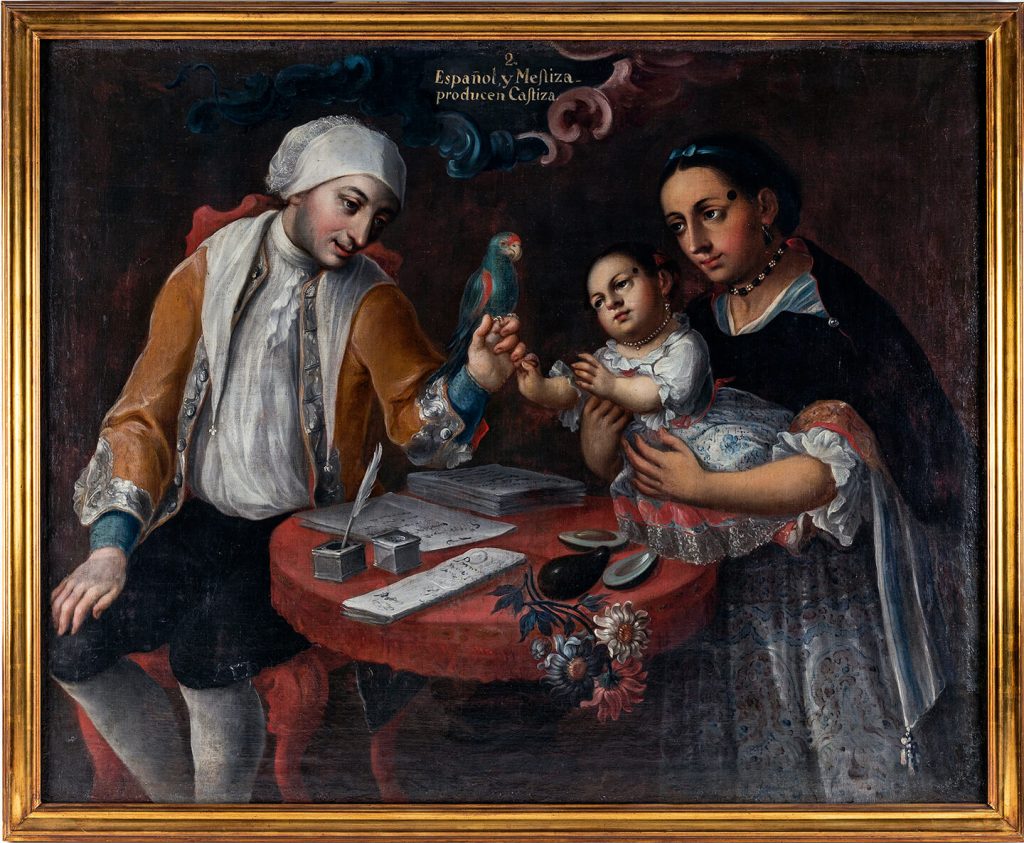
Here the painter depicts and names each figure as “types” rather than individuals. The label designating their social caste (thus the name casta in Spanish) appears in a cartouche at the upper edge of the scene: 2, Español y Mestiza, producen Castiza. This painting, like the Manglano-Ovalle DNA prints, would have been one of a set, often a set of sixteen. To show the full extent of the casta “types,” figure 3 offers a rare surviving example of a casta painting that includes all sixteen within the space of single canvas.[4] It was created by Ignacio María Barreda in 1777 (figure 3). [402]
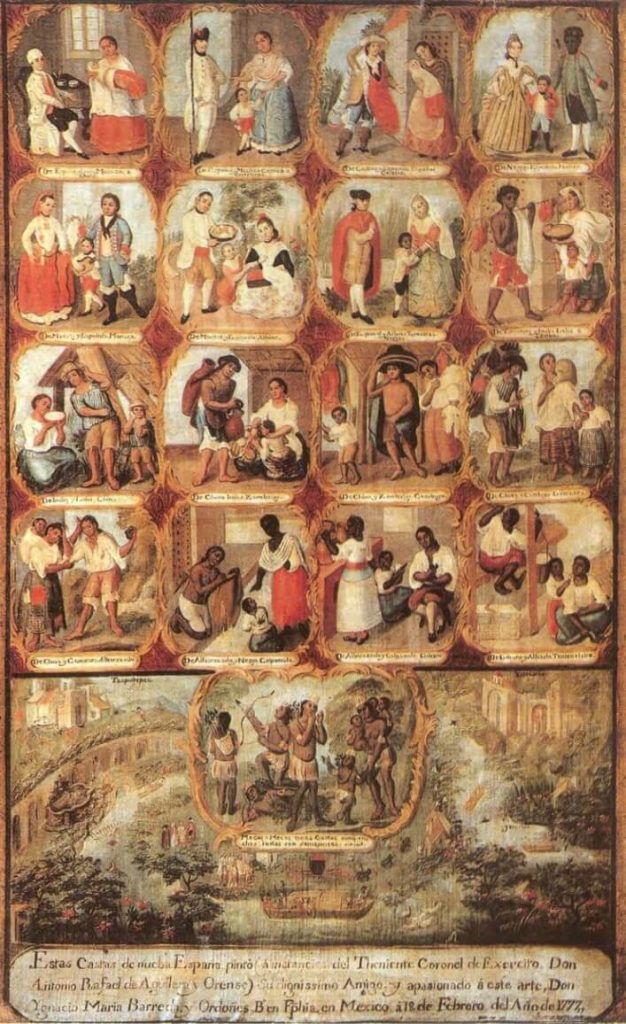
As viewers moved from the first painting in a casta series to the last, the imagery would show the permutations that could occur when members of the three primary social “castes” of the period — labeled español [Spaniard], indio [Indian], and negro [Black] — produced children.[5] Typically, series of castas show those labeled as español or española as being better dressed, and enjoying leisure activies rather than working. In figure 3, for instance, the leisure of the four families at the top of the canvas, each of which includes a person labeled as español or española, contrasts markedly with the laboring members of other castes in the rows below. In the bottom row of the left column, a family fight erupts. Figure 2 is the second panel of a different casta series, and in it, a male of Iberian origins (labeled as español) and a woman of Indigenous and Iberian parentage (labeled as mestiza) have produced a child labeled as castiza. As Magón renders it, the daughter’s skin color appears slightly darker than that of her father but lighter than that of her mother. This was not the painter’s invention, rather, he depended upon a representational system and racialized thinking that was common in casta paintings: since the child’s combined ancestry would have been calculated at one-quarter Indigenous and three-quarters Spanish, she has been depicted as lighter than her mother but darker than her father. Whether fashioned by painters of local renown or those of mediocre skill, casta paintings suggested to their viewers that ethnic designations in New Spain could be distinguished by skin color. These artworks also tied wealth and social standing to biological ancestry. And because of this, casta images fueled a version of the racialized imaginaries of their era.
In referencing casta paintings, the contemporary artist Manglano-Ovalle envisioned a genealogy of artworks, that is, he was thinking about how his own work descended from, and was indebted to, earlier portraits [403] of families. In this essay, we follow his lead, exploring genealogies of racialized thinking as they were expressed in the Spanish Americas in images. Central to our claims about the history of race is that visual imagery, especially imagery focused on family lines, played a crucial role (and indeed, still does) in both articulating and obscuring the instabilities that come into play as human bodies are racialized. The term “race” may have developed in the early modern period, but it was not generally used in the Spanish Americas. Yet, some of the themes that figure most prominently in constructions of race, at least as now recognized, found expression in this visual culture. In what follows, we enlist the term “racialized” to underscore how varied are the historical processes that people, today, associate with the concept of race. We do not believe that the casta system of the Spanish Americas was the only precursor to today’s constructions of race.[6] Rather, as Manglano-Ovalle’s print suggests, elements of the past filter into the present, but they never come unchanged (a DNA scan is not a casta painting, after all). Central to this essay, then, are the ways in which family portraits and casta paintings sustain — but also challenge — ideas of difference and belonging, sociality and biology. Using genealogy as a lens, along with the interpretive tools of art history, we seek to better understand how habits of racialized thinking and practices of visual evocation supported each other over time in colonial Latin America, a place that was a crucible of ethnic mixing.
Colonialism and the Renaissance World
The Americas, we must emphasize, are crucial for any consideration of “race in the Renaissance” because the colonial experiences that unfolded there transformed the early modern world. Western European decisions to cross the Atlantic in the fifteenth century and, upon arrival, to extract wealth (silver, gold, dyestuffs) via human labor led to dramatic relocations that remodeled the globe. Some travel, largely from the Iberian peninsula [404] and other parts of Europe, was voluntary. By the mid-sixteenth century, however, many who came to the Spanish Americas were brought by force from Africa, especially west and central Africa via the massive expansion of the slave trade, and from Asia, via the Philippines. This global movement of human bodies fueled the development of colonial societies, particularly urban societies, and contributed to unprecedented linguistic and cultural diversity. Well before the sixteenth century drew to a close, cities in the Spanish Americas — Lima, Mexico City, Santo Domingo, and Potosí — could be counted among the most cosmopolitan and ethnically complex settings of early modernity.
Urban experiences would not have been unfamiliar as urbanism had long been important in the Americas. Under both Inka rulers (c. 1438–1534) and their Mexica counterparts (who are often better known today as the Aztecs, c. 1345–1521), bustling, multi-ethnic cities functioned as economic engines, driving sophisticated imperial ambitions. These cities were contemporaneous with Florence, led by Medici scions, Istanbul, ruled by Ottoman sultans after 1453, and Beijing, steered into prosperity by Ming emperors. And while America’s cosmopolitan history does not usually come first to mind when one thinks of the Renaissance, it probably should. When Hernando Cortés (1485–1547) and his troops and allies wrested the Mexica capital of Tenochtitlan from Motecuhzoma (c. 1466–1520) and Francisco Pizarro (1478–1541) and his soldiers took the Inka capital of Cuzco from Atawalpa (c. 1502–1533), their regicides and brutal tactics established patterns of violence that spread rapidly across the Americas. This is one implication of Walter Mignolo’s now familiar phrase, “the darker side of the Renaissance.”[7] Of course, military campaigns were not the only force in the transformation from Abya Yala, Tawantinsuyu, and Aztlán into “the Americas,” and Indigenous histories should not — in fact, cannot — be written only in relation to Europe. Yet the unchecked practices of enslavement, the violent overthrow of Indigenous empires, the imposition of religious beliefs by the Catholic church and the economic cravings of the Habsburg rulers that drove them to occupy foreign lands, [405] gave rise to patterns of oppression and social reordering whose effects persist. Eventually, settler colonialism fostered new patterns of belonging and exclusion that, often, were most keenly felt in cities of the Spanish Americas. This essay presumes that neither settler colonialism in the Americas nor the racialization that it fostered were ever just American stories, nor are they strictly early modern histories: the “Americanization” of the “Renaissance world” forced understandings of the globe to shift fundamentally.
The projects of settler colonialism radically altered the daily life of millions of people, from the island of Cuba to the highlands of Bolivia, as disease, enslavement, famine and war took the lives of thousands upon thousands of Indigenous people in the first decades after Habsburg emperors laid claim to the Americas. However, it was in the cities that foreign ambitions made some of their strongest visible marks. This can be seen in architecture and urban planning. Even more profound were new forms of sociability. Under the imperial rule of Charles V (1516–1556) and his son Phillip II (1556–1598), enslaved people — from Africa and India, Southeast Asia, and the Philippines — and their descendants labored in and learned to share urban spaces, with each other and with those who claimed Indigenous or Iberian ancestry. Urban residents met face to face in colonial courts, watched each other dress in finery for Catholic festival processions, and bargained for goods in markets. By 1600, people with complex ancestral ties regularly courted and married; they also had extramarital relationships (whether coercive or not) and, along the way, bore and raised children. While many early modern cities drew people from around the world, creating cosmopolitan communities, it is our contention that the complexity and extent of ethnic mixing in what is today Latin America, both physically and conceptually, set this region’s history apart. Within the Habsburg American empire, settler colonialism demanded many levels of social control to build extractive economies. Central to this colonial project was the social recognition of ethnic difference, and the concomitant creation of new hierarchies based on ethnicity. One ideal enlisted consistently in the project of settler colonialism was the monogamous family, and with it, representations of genealogical connections that bolstered ideological positions that it was “natural” for some people to belong together, but not others. As we understand early modern [406] history, embedded in the naturalized monogamous family is a dominant thread of racialized thinking that later gets twisted into concepts of race. These ideas were made present via the visual culture of the period.
Family Ties: Painting Genealogies in the Sixteenth Century
Indigenous people living in central Mexico in the 1540s and 1550s, along with enslaved people transported forcibly from Africa and Asia, remembered and commemorated their forebears and lineage through acts and images that built upon centuries of oral tradition and ritual practice. Painted imagery created by Africans and Afro-descendant communities does not survive in great quantities from the early colonial period. Surviving Indigenous manuscript scenes of rulers, their children, and their ancestors, however, represent an important form of memory-keeping. Because political and territorial rights were shifting dramatically in the mid- to late-sixteenth century, such paintings might be kept locally; others were presented in legal contexts, some being made expressly for that purpose. Nearly all of the works known today rely upon modes of image-making with diverse origins. This is the case with the ink-on-paper painting that presents the family tree of Gaspar Antonio Chi (c. 1532–1575), a well-educated Maya man and member of a powerful family in the Yucatán (figure 4).
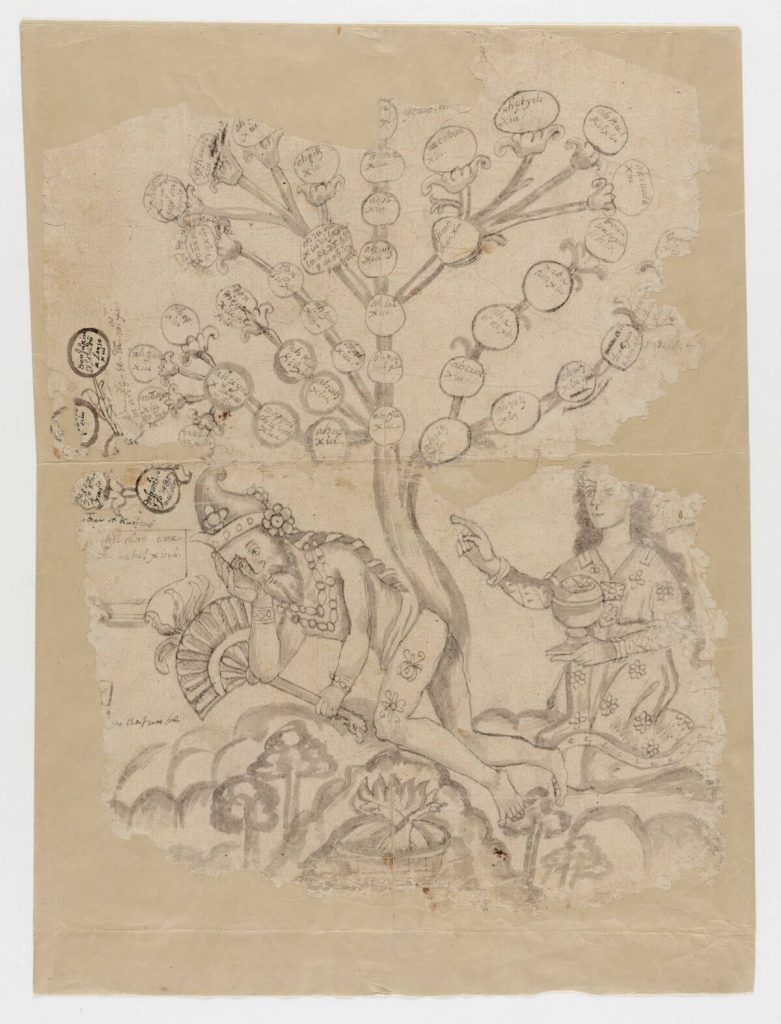
Having been taught Catholic doctrine and practice by friars in the town of Maní, and having worked with Spanish officials as an interpreter, Chi knew more than a little about Christian forms of painting and European writing. A man of noble descent who would later become the bacab [leader] of Maní, Chi created many images in the sixteenth century that charted his family’s claims to status and territory.[8] The image shown here depicts his family tree by reworking the Biblical theme of the Tree of Jesse. Typically, Trees of Jesse show this Old Testament prophet reclining at the bottom of the image. A great tree grows from his crotch and his descendants [408] are pictured on its branches. At the top of this genealogical tree is Jesus. Here, instead of representing Jesse as the progenitor, Chi paints his Maya ancestor, Tutul Xiu. As the progenitor, he rests upon one elbow and holds an Indigenous-style fan in the other hand. The leg tattoos are familiar from Maya tradition, although upon Tutul Xiu’s head perches a crown that resembles those worn in central Mexico by Mexica (but not Maya) royalty. Since the image has deteriorated over time, the name of the woman dressed in an Indigenous-style garment who kneels beside Tutul Xiu is no longer known, although she may well have been his wife. Along with its direct biblical reference, this painting enlists metaphors drawn from the plant world: a tree grows from the male ancestral body; its branches bear dozens of blossoms, each with the name of Tutul Xiu’s lineal descendants. One of them is Ix Kukil, the mother of the painter, Gaspar Antonio Chi. This painted work, kept by Chi and later generations in Maní, makes it clear that knowing one’s blood relations was an important part of colonial thinking in the Spanish Americas — and not only among settlers from Europe. As if to reaffirm the point, in the foreground of the scene two crossed deer legs, set aflame, smolder in front of a cave, a likely reference to ancient Maya rites for commemorating ancestors.[9]
Chi’s image makes the connections among family members seem to be naturally occuring processes, like the growth of a plant, so that all who belong to his family are rooted in the body of a single, primordial ancestor. The biological metaphor fuses with one that is Christological, since, in Christian belief, the Tree of Jesse gives rise to the Christian savior, connecting Chi’s family line to the right and natural order of things. Not all sixteenth-century family portraits, however, invested so heavily in natural and religious metaphors. Not even in Europe. A painting from the mid-sixteenth century of King Henry VIII of England (1491–1547) and his relatives, offers a case in point (figure 5). [409]
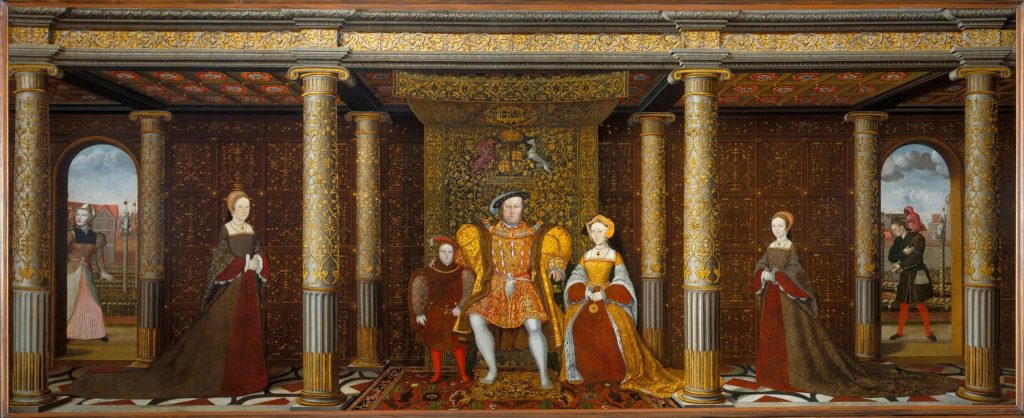
The monarch, seated on his throne with his stockinged legs splayed, anchors the scene. His body aligns with the central axis and serves as pivot for the painting, as other figures have been positioned like parentheses to frame him. Closest to Henry is his third wife, Jane Seymour (1508–1537), and their son, Edward (1537–1553), Henry’s first and only surviving legitimate male child. Farther from the king and his heir and mother, stand two of Henry’s daughters. Neither of these women is the child of Jane Seymour; rather, one is Mary (1516–1558), daughter of Catherine of Aragon (1485–1536), Henry’s first wife; the other is Elizabeth (1533–1603), daughter of Anne Boleyn (c. 1501–1536), his second wife. Toward the edges of the painting, in the outdoor scenes, are members of the court, not relatives. Along with proximity to the monarch, the contrast between interior and exterior space offers a visual cue as to who “belongs” to Henry’s family line. While the meaning of some of the painted imagery in this scene is still debated by scholars, the central theme of the painting is crystal clear: this is the family of the king, potential heirs to his throne.[10] [410]
At first glance, both Chi’s family tree and the portrait of Henry VIII and his family stake claims about the politics of lineage that seem to shed little light on questions of race. This is because the paintings draw upon and reaffirm normative habits of thinking and practice. The “whiteness” of the figures in the English royal portrait might strike modern eyes as inevitable, but it actually describes a long history of exclusionary customs. Although Afro-Europeans were among the members of the English court, they are not pictured here.[11] Furthermore, this image negotiates lineage in relation to (if not also through) Henry’s body: Mary, Elizabeth, Edward, and the king all share some genes. Yet the scene is a fiction, and not only because Jane Seymour had been dead for years when the painting was created. While the painting situates Edward closer to his father than his sisters, this was a legal rather than genetic “truth.” Following English law of the time, the male prince would inherit Henry’s throne first. This portrait, then, projects a hope: that the male line matters more than other blood relations. In the case of Chi’s family tree, the question is certainly not one of whiteness, nor is it one of Indigeneity, at least not in any straightforward way. By the time that scene was painted, the political prerogatives of elites in the Yucatán depended upon possession of verifiable Maya — not simply Indigenous — identity and heritage. It is the claim to this possession that Chi’s painting makes visible.
Setting Chi’s painting of Tutul Xiu and his descendants alongside that of Henry VIII and his kin, pairs two Renaissance-era paintings that together highlight the distinct ways that imagery could be enlisted in the mid-sixteenth century to visualize elite commitments to a male progenitor and to describe one’s family ties to others. Both paintings trade in cultural certainties about ancestry and genealogy that were widely shared in the Christian worlds of their day, be they English Christian or Maya Christian. Indeed, these images show how lineage could be tracked and traced, not only remembered. Both paintings also minimize aberrations and breaks, [411] if not also the shifting fortunes among family members. In so doing, these works stress how “natural” it is to organize human connections through biological metaphors and genealogical premises. Viewed today, when contemporary ideas of belonging and exclusion, and of family, are quite different than in the sixteeenth century, these two paintings offer insight into how people in the past used images to make sense of family relations and lineage. Later casta paintings offer somewhat different possibilities, because they were created in settings where the urban environment, immigration, and slavery produced far more complex ethnic and social differences than those of the sixteenth century. Because of the colonial economies and habits of negotiating inclusion and exclusion in the late seventeenth and early eighteenth centuries in the cities of the Spanish Americas, casta paintings evoke very particular kinds of daily work and creative labor.
Painting Castas in the Eighteenth Century
Since the violent imposition of settler colonialism in the Spanish Americas depended upon social hierarchies that privileged people of European (and especially Spanish) descent and their heirs over others, it is hardly suprising that concerns with the naturalization of social difference take new and more potent forms over time. Hence, an increasingly explicit articulation of a hierarchical system of castas surfaces in paintings of the eighteenth century, and this differs from the kinds of hierarchies depicted in the paintings of Henry VIII and by Gaspar Antonio Chi that we have been considering. At their core, casta paintings, similar to the sixteenth-century examples, are founded on the forced union of social identities with genealogy. They also implicitly reject the idea that social identities were or could be fluid and performative. But, in distinction to what came before them, casta paintings never portray a phonetypically homogeneous or “pure” casta family. There are, for instance, no known examples of a mestizo child with mestizo parents. Instead — and this is fundamental — these images are interested strictly in categories that arose when different castas produced children. Casta paintings therefore address a driving concern with cultural mixing and its manifestation in phenotypes, or visible features, like skin color. No less significantly, these paintings seem to [412] offer irrefutable documentation of what was, in reality, an unstable system, given that the categories that the casta paintings promoted were not necessarily the ones people used to classify themselves. Indeed, in their neat assignment of every person pictured into one of sixteen available categories, casta paintings imply certainties rather than instability.
In the Spanish Americas, as noted above, the terms and concepts of “casta” and “castas” represented but one way to think about ethnic difference. Most days one’s casta designation would not have been voiced aloud, although the concept of castas formed a distinctive way of categorizing and thinking about people. Just who belonged to what caste was a source of anxiety, particularly among the elites of Spanish America who considered themselves one of the pure español [Spanish] castes. It is not surprising, then, that castas were surveilled and commented upon in censuses, legal documents and personal letters. Across the early eighteenth century, long after castas had become a familiar part of colonial society, they also became the focus of a unique form of visual representation: casta painting. Today, these paintings are recognized as some of the most explicitly racialized images created in the early modern period. As paintings that depict histories of miscegenation in seemingly benign terms, these works are both confounding and unsettling. Rarely are the social and economic permissions and exclusions of a society so frankly expressed in painting.
As with the paintings by Magón and Barreda (see figures 2 and 3) or the example discussed below by a painter whose name is no longer known (figure 6), all works in this genre rely upon mimesis, depicting domestic scenes and other aspects of daily life as if the painters witnessed what they painted. This taken-from-life quality adds to the illusion that these paintings document lived experience. In the Magón painting, for instance, the man has been working at his desk. The feathered pen resting in an inkwell and the brightly colored parrot perched upon his finger imply he has just taken a break from his correspondence, perhaps having been interrupted by the woman cradling the well-fed, well-dressed child. A small bouquet of flowers and two avocados, a fruit with origins in the Americas, sit at the table’s edge. The stack of papers confirms the father is an educated man; he is also a person who can afford luxuries. Although artfully composed, the scene does not over-stretch one’s imagination: this all could have existed. [413]
Despite their mimetic claims, their true-to-life quality, all scenes in casta paintings are conjured and imagined. As part of this constructed urban world, people in casta paintings appear primarily as examples of genetic mixing. Moreover, in these scenes, people of presumed “purer origins,” be they “purely” Spanish, Indigenous, or Black, and lighter skin are shown occupying the highest rungs in colonial social and economic hierarchies. Along with their emphasis on the nuclear family, which forms one consistent feature of casta painting, these artworks feature descriptive ethnonyms, each of which carried distinctive connotations. For instance, the term español did not necessarily root identity in one’s place of birth as España [Spain]. An español might be born in New Spain or Iberia, but the label signaled those with ancestors who were both Spanish-born and Christian (Catholic). The term indio had stronger geographic connotations, referencing people who came from the Indies (as Spain’s overseas possessions were called). And according to the casta painting labeling scheme, negros [Blacks], were largely untethered from geographic origins, defined instead by skin color. Taken together, these labels make clear that a significant part of the work of settler colonialism lies in racializing people and geographies, inventing and using logics that this form of colonialism authorizes.
There is still much unknown about the casta genre, including how people of the past read such images or why, precisely, one might purchase such a painting or send it across the Atlantic Ocean to Spain, where many, including Magón’s and Barreda’s paintings, are found today. Casta paintings nonetheless invite thinking about what constitutes a normative family and an acceptable human body in colonial contexts. For instance, casta paintings, featuring family portraits, rule out procreation via extramarital relationships or rapes. They also exclude elders and extended groups of relatives from the family group. Instead, these paintings suggest that in the Spanish Americas all families were composed of heterosexual pairs who give birth to one or two children (at most). In this painted world, both poverty and wealth are bound to one’s genetic code and any hope of changing castas — of racial passing — is foreclosed.
In lived reality, as revealed by historical documents, castas were never so neatly or definitively fixed, nor were families and households so narrowly circumscribed. For although the casta paintings imply that naming [414] ethnic types was of paramount importance, people in the Spanish Americas also recognized that aspects of one’s identity could be chosen and enacted: they were performative. In Mexico City, for instance, different facets of social identities came into play, day by day and year by year. In the marketplace, one’s economic standing was preeminent; whereas in the viceregal courts, rank and genealogy mattered most. When the census taker came knocking on the door, he might well want to know how many males resided in a particular house, and also whether they were españoles or mestizos. Yet census counts reveal that while some categories, like español and mestizo and mulatto were legally recognized in the eighteenth century, other terms that surface in casta paintings were not, such as albino (technically, a person with a congenital absence of pigment, but used in casta paintings for a person with one Black great-great-grandparent among otherwise español forebears) and negro torna atrás [Black throwback]. Moreover, even recognized casta terms were not securely affixed to individuals — in lived experience (although not painting) people could slip into more desirable castas should circumstances permit.[12]
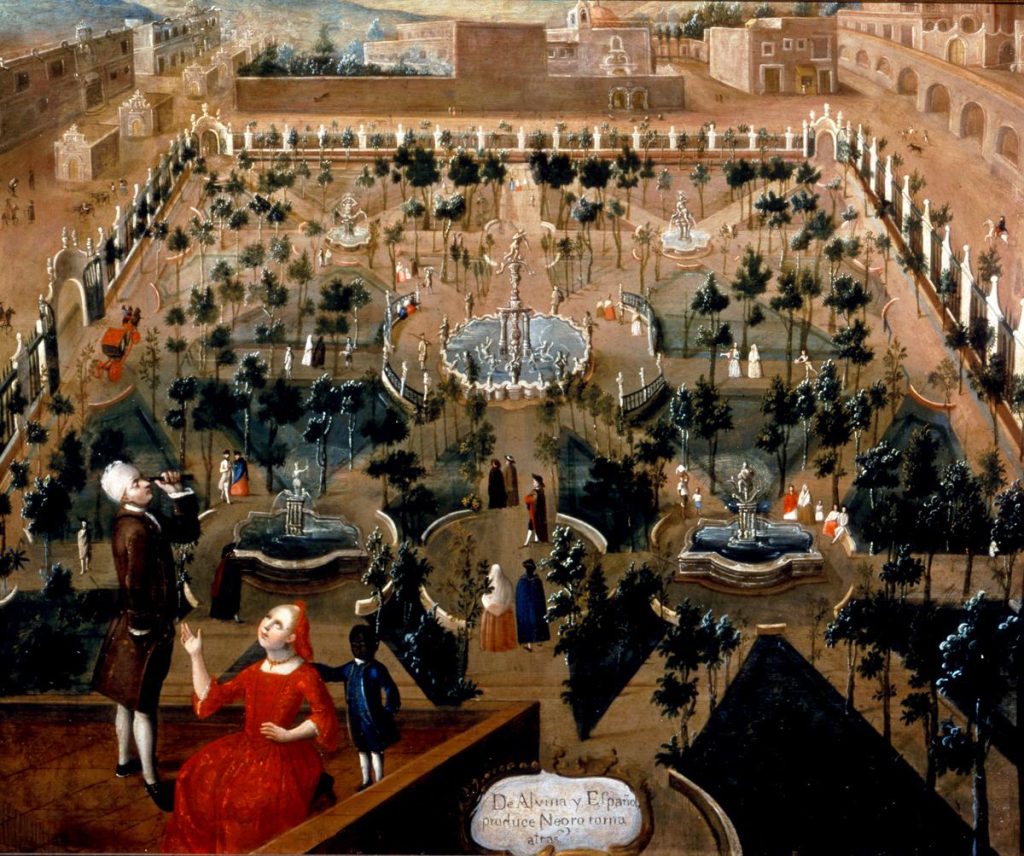
By stating casta categories so concretely, and by supplying images that attest to their veracity, casta paintings seem to crowd out other means of social divisions used in their day. However, casta paintings are contradictory in that they also offer visual evidence of one of the most important means of enacting social fluidity: clothing. In the painting titled De Albina y Español produce Negro torna atrás [Albina and Spaniard Produce a Black Throwback], c. 1770–1780 (see figure 6), each family member depicted in the foreground of the scene belongs to a different casta, yet all are dressed in luxury fabrics, carefully tailored. This implies the trio shared the same economic status: nice clothes were expensive, and poor people had access only to simple fabrics, often undyed. But in Mexico City and other urban settings, costly fabrics were an unstable marker of economic status, in part because in wealthy households, servants sometimes had access to cast-off clothes, and open markets meant that luxury [415] cloth was available to everyone who could afford it. The unreliability of clothing-as-status-marker was an irritant to the Spanish crown government, who frequently issued edicts meant to rein in the wearing of luxury clothes by non-elites. Nevertheless, clothes continued to circulate in spite of sumptuary laws. In casta paintings, then, what people wore is a catalogue of possibility, not necessarily tied inextricably to one’s ethnicity. Even so, casta painters sought to convince their viewers that the genetic codes of people of the Spanish Americas were predictable and largely immutable, and that these, rather than individual choice or performances, determined social order. Painters therefore lavished more care on the clothes of elite castas than they did of those who were impoverished. This is part of their commentary on social and ethnic norms, [416] implying that clothing the wealthy, who were also the least “mixed” castas, required both others’ labor and an eye for aesthetics, not merely money.
The scene in figure 6 also seems to contradict the idea that social personhood could transcend biological or genetic “destiny.” At first glance, this casta painting presents an idyllic scene. The Alameda, a public park at the edge of Mexico City, fills much of the image. The painter has tilted the picture plane so that viewers can appreciate the strict geometry of park paths, their crossings marked by fountains. If we compare this scene to the casta painting by Magón (see figure 2), we sense how painters shaped the genre to fit different visual tastes. Here, in contrast to Magón’s intimate interior, we see a busy setting. Small figures, mostly in pairs or groups of three, stroll through the park. In an ambiguous space in the left foreground, perhaps a rooftop with a view onto the park beyond, appear three figures: a white-skinned man and woman and a Black child, all dressed in elegant and fashionable clothing. The woman and child both turn to look at the man, who raises a telescope to survey the park. The painted caption at the lower center edge of the painting — De Albina y Español produce Negro torna atrás — tells viewers that the three people are, indeed, biologically related. The terms, “albino/a,” “Spaniard,” “Black throwback,” are all well-known descriptors in casta paintings. According to the logic of such paintings, español or española was one of the three original, unmixed castes, along with Indian and Black. In contrast, an albino/a (according to the same typological logic), was not purely white. Although the text doesn’t specify who is who in the scene, it is not hard to parse the image. Since it takes two sexually mature people to produce a child, the albina and español are the adults in the picture — the gender specificity of Spanish (albina is feminine, español, masculine) distinguishes them even further. The Black child is their issue, but he is not just any child. The descriptor “torna atrás” is meant to explain how light-skinned parents could produce a child of very dark skin. In using this phrase, the painting offers visual testimony on genetic destiny: that children with one Black great-great-grandparent could “torna atrás” (literally, turn around) and manifest the skin color of this one ancestor. In casta paintings, there was no escaping one’s family genetics, no amount of inter-marrying that could “whiten” a Black ancestral line. Yet this kind of indelible marker of ethnicity did not exist, the sets of casta paintings suggest, for those with [417] Indigenous ancestors, where, after four generations of marriage of one member of the indio casta with the español casta, the resulting child was unreservedly español. This contrast makes clear that the torna atrás is premised on anti-Blackness, which was hardly a fantasy of casta paintings. It was, and remains a social reality in the Americas. Both in settler colonial societies and today anti-Blackness persists, and who can lay claim to a particular ethnicity remains crucially important.
Casta Complications and Bodily Limits
No viewer in the past looked at a casta scene in isolation. Rather, these paintings formed part of a rich visual culture in urban environments, themselves awash in imagery. In urban painters’ studios where casta paintings were created, other images were being produced as well. On the easels of a painter’s workshop, one might find a casta painting, as well as a painting of a miraculous intervention of a religious statue that had cured a sick person. Outside the studio, being hawked on the streets were printed images, some documenting religious miracles, others showing marvelous and monstrous events, like the birth of a baby with a pig’s head or conjoined twins.[13] Setting the casta painting of the español, albina, and torna atrás against these kinds of images, reveals that visual imagery in this period was often about the outer limits of the possible, not strictly (or even largely) meant to document the normative. Most people did not fear that their children would emerge with different phenotypes than their parents, and most did not really worry that their children would be born with pig’s features. But people did look to images to ruffle up staid traditions, to be sensational, to show the unexpected. Given this, we might well read figures like the torna atrás not only as a cautionary tale about the longevity (if invisibility) of African-derived bloodlines but also as a figure, like the miraculous, that exists at the boundaries of known realities. [418]
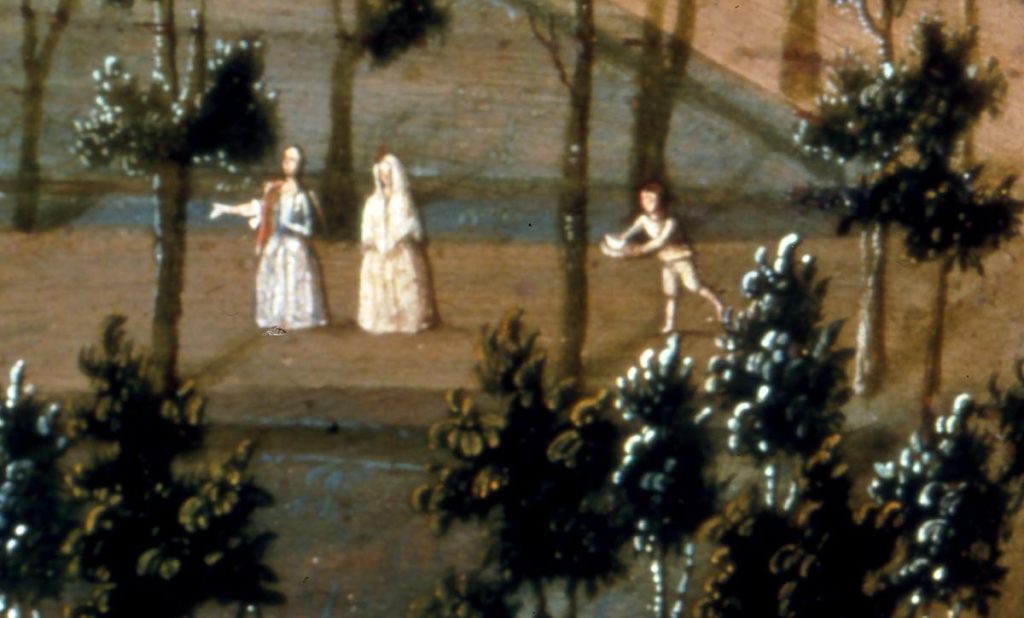
In addition, some casta paintings seem to reveal an awareness of the limits of their own racialized propositions. If we return to the Alameda in figure 6 and look beyond the casta family, we see a small boy chasing after a heavily veiled woman and her attendant (figure 7). He is delivering a cup — almost certainly chocolate, a beverage enjoyed by elite women in Mexico City; he is running, we suspect, so that the chocolate would reach the women while still frothy. Nothing pictorial marks his casta, but his activity makes it clear he is a servant. And the veiled woman, as the recipient of the chocolate, is certainly elite, her status emphasized by the quantity of fabrics she wears. In another part of the park, a male figure holds a wide basket on his head, and carries a narrow-necked vessel, implying he is a street vendor (figure 8). In showing a world divided between the servants and the served, the background of this painting suggests that people knew full well that social distinctions other than caste were at play in their daily lives. This may not have been the primary tale that casta painters wished to tell or the patrons of their paintings wished to see. As with much racialized imagery from early modernity, however, cracks and [419] seams are inevitable. They, too, are part of the system and logic of racialized thinking.
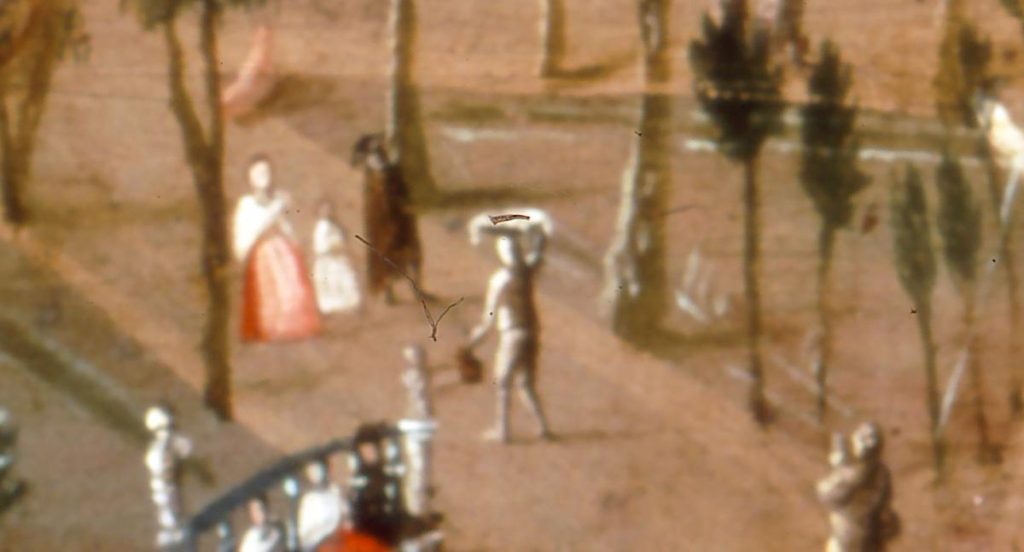
If one looks at casta paintings through a historical-materialist lens, wherein images are superficial justifications for an underlying social order determined by even deeper economic forces and relationships, it is possible to argue that their painted surfaces offer little more than falsified justification for social hierarchies, many of which are rooted in economic exploitation, including enslavement. And in fact, paintings do describe one general economic truth: the families they depict that are headed by men identified as español are commonly shown as more prosperous, and more likely to engage in leisure activities than families headed by other castas. The basis for such claims about Spanish economic power had its roots in Iberian conquests of the Americas in the sixteenth century and the particularities of settler colonialism. To many viewers of the day, the rejection of hierarchies would have been unthinkable: to them, societies were properly hierarchical, and a naturally-based hierarchy, beginning with human dominion over animals, men’s dominion over women, and [420] adults’ dominion over children, offered the best blueprint for a successful, functioning society.
Many modern eyes tend to see casta paintings as misguided representations, evidence of errant ideologies. Not only were their patriarchal and racialized hierarchies inextricably intertwined with practices of colonial oppression, they also express a deep anti-Blackness. For some viewers today, who see themselves as having overcome absurd and suspect notions such as resurgence of a Black phenotype, casta paintings produce not a little schadenfreude. Indeed, it would not be wrong to take these images to task. In very fundamental ways, they describe ways of thinking and understanding human biology and lineage that misalign with twenty-first-century understandings of lived experience. While casta paintings were popular for only a few decades, they were commissioned by art collectors, colonial officials, foreign diplomats and local residents. They have since become canonical in Latin American art. So, what were casta paintings good for in the past? Why might people have wanted one?[14]
In Mexico City, as in other cities of the early modern world, the visual expression of identities was rarely happenstance. One’s clothing and habits of speech, the ways one moved through parks and plazas — with servants, in coaches, or on foot with children in tow — offered cues to one’s social and economic status and, by extension, one’s family history. Casta paintings told their viewers that choices were few if one wanted to shift one’s place in society: biology was destiny. This was neither wholly accurate, nor completely wrong. Shifts could be made, but ambition was never enough to climb out of poverty or take a leadership role in metropolitan government. In the Spanish Americas — as in many places of the world today — mobility was also tied to phenotype. In colonial society, the lighter one’s skin, the more opportunities one might have. Such privilege could of course be squandered, but if the torna atrás shown in Figure 6 came to life, he would have a tougher path to tread than would his mother and father, no matter their wealth, no matter that their lineage was primarily español. What people could see about a person, especially in the public realm, set the parameters and permissions of daily life. [421]
It is hard not to say the same of the present. Yet in closing, we wish to forestall any over-quick elisions. As the digital prints of Manglano-Ovalle with which this essay opened suggest, the kinds of racialized thinking and pressure put upon visibility and phenotype in eighteenth-century Mexico City is not quite the same as in the twenty-first century. Casta paintings invite us to ask: Is who we are and who we wish to become more negotiable today than it was in the past? Are some identities easier to perform than others? As Patrick Wolfe has argued, settler colonialism is a structure, and so, the social, economic, and racializing relationships it constructed across Europe, Africa, the Americas, and Asia will forever be difficult to dismantle.[15] What happened in the fifteenth and sixteenth centuries — events and practices that invented the Americas, turned them into a “New World,” and then through violent dislocations of Brown and Black bodies, brought them into closer contact with other parts of the world — still shapes the world today. Among other things, this form of settler colonialism bound genealogy and genetics to skin color and identity. Given modern desires to see, and thus to know who someone “really is,” is it possible to trace a legacy of casta paintings that endures today?
Discussion Questions
- The chapter posits that many parts of identity are performative. Are some identities easier to perform than others?
- The chapter uses the methods of art history to ask, and answer, questions raised by paintings. In what significant ways does this approach differ from chapters in this volume that focus upon historical documents or literary texts?
- The rigid “caste” structure that casta paintings present was never reflected in lived experience. In the contemporary world, can you identify instances of similar fictionalized representations of the social order? How would you analyze their relationship to lived experience? [422]
Suggestions for Further Reading
Bryant, Sherwin, Rachel O’Toole, and Ben Vinson III., eds. Africans to Spanish America: Expanding the Diaspora. Urbana: University of Illinois Press, 2012.
Carrera, Magali. Imagining Identity in New Spain: Race, Lineage and the Colonial Body in Portraiture and Casta Paintings. Austin: University of Texas Press, 2003.
Deans-Smith, Susan, and Ilona Katzew, eds. Race and Classification: The Case of Mexican America. Stanford: Stanford University Press, 2009.
Lugo-Ortiz, Agnes, and Angela Rosenthal, eds. Slave Portraiture in the Atlantic World. Cambridge and New York: Cambridge University Press, 2013.
Memories of Underdevelopment: Art and the Decolonial Turn in Latin America, 1960–1985 // Memorias del subdesarrollo : arte y el giro descolonial en América Latina, 1960–1985. San Diego: Museum of Contemporary Art, 2018.
Seijas, Tatiana. Asian Slaves in Colonial Mexico: From Chinos to Indians. New York: Cambridge University Press, 2014.
Bibliography
Barteet, Cody C. “Maya Heraldic Arms: the Merging of Spanish and Maya Visual Cultures in the Memorial Shield to the Massacre at Otzmal.” Konsthistorisk tidskrift/Journal of Art History (2017): 1–22.
Cortez, Connie. “New Dance, Old Xius: The ‘Xiu Family Tree’ and Maya Cultural Continuities after European Contact.” In Heart of Creation: The Mesoamerican World and the Legacy of Linda Schele, edited by Andrea Stone, 201–215. Tuscaloosa and London: University of Alabama Press, 2002.
Deans-Smith, Susan. “Creating the Colonial Subject: Casta Paintings, Collectors, and Critics in Eighteenth-Century Mexico.” Colonial Latin American Review 14, no. 2 (December 2005): 169–204.
Earle, Rebecca. “The Pleasures of Taxonomy: Casta Paintings, Classification, and Colonialism.” William and Mary Quarterly 73, no. 3 (July 2016): 427–66. [423]
Floyd, Emily. “Privileging the Local: Prints and the New World in Early Modern Lima.” In A Companion to Early Modern Lima, edited by Emily Engel, 360–384. Leiden and Boston: Brill, 2019.
García Saíz, María Concepción. Las castas mexicanas: Un género pictórico Americano. Milan: Olivetti, 1989.
“Glenn, Dario and Tyrone,” Guggenheim Online Resources. Accessed at: https://www.guggenheim.org/artwork/10464.
Hampton Court Palace. “Henry VIII: Renaissance Prince or Terrible Tudor?” Website accessed at: https://www.hrp.org.uk/hampton-court-palace/history-and-stories/henry-viii/#gs.813urj
Katzew, Ilona. Casta Painting: Images of Race in Eighteenth-Century Mexico. New Haven: Yale University Press, 2004.
Leibsohn, Dana, and Barbara E. Mundy. “Genealogical Tree of the Xiu Family.” In Vistas: Visual Culture in Spanish America, 1520–1820. http://www.fordham.edu/vistas, 2015.
Lloyd, Christopher, and Simon Thurley. Henry VIII: Images of a Tudor King. London: Phaidon Press Limited, 1990.
Loveman, Mara. National Colors: Racial Classification and the State in Latin America. New York: Oxford University Press, 2014.
Mignolo, Walter. Darker Side of the Renaissance: Literacy, Territoriality, and Colonization. Ann Arbor: Michigan University Press, 1995.
Platt, Ron, ed. Iñigo Mangalo-Ovalle: The Garden of Delights. Winston-Salem: Southeastern Center for Contemporary Art, 1998.
Rappaport, Joanne. The Disappearing Mestizo: Configuring Difference in the Colonial Kingdom of New Granada. Durham: Duke University Press, 2014.
Rawlinson, Kent. “Architectural Culture and Royal Image at the Henrician Court.” In Henry VIII and the Court: Art, Politics and Performance, edited by Thomas Betteridge and Suzannah Lipscomb. Burlington, Vermont: Ashgate Publishing Company, 2013.
Van Deusen, Nancy. Global Indios: The Indigenous Struggle for Justice in Sixteenth-Century Spain. Durham and London: Duke University Press, 2015.
Wolfe, Patrick. “Settler Colonialism and the Elimination of the Native.” Journal of Genocide Research 8, no. 4 (Dec. 2006): 387–409.
- The series, of forty-eight individual prints arranged into sixteen triptychs, is named after Hieronoymous Bosch’s sixteenth-century triptych, The Garden of Earthly Delights. For his project, Manglano-Ovalle not only enlarged the DNA scans, he accentuated their color patterns and mounted the prints on acrylic panels approximately five feet in height (not quite life size). See Ron Platt, ed., Iñigo Manglano-Ovalle: The Garden of Delights (Winston-Salem, NC: Southeastern Center for Contemporary Art, 1998). For a description of this triptych: https://www.guggenheim.org/artwork/10464. ↵
- In this essay, the “Spanish Americas” refers to those parts of North and South America and the Philippines under Habsburg and Bourbon control, from roughly 1520 to 1820. ↵
- The scholarship on casta painting is extensive, and growing. For a range of perspectives and a selection of foundational works, see bibliography. ↵
- While some casta series are still intact, most museum collections have partial sets or individual paintings. ↵
- Casta was not the sole category used to distinguish among different social groups. Calidad (quality) was another dominant term, which “transcended phenotype by revolving around questions of individual status and the behaviors appropriate to different social ranks,” Joanne Rappaport, The Disappearing Mestizo, Configuring Difference in the Colonial New Kingdom of Granada (Durham and London: Duke University Press, 2014), 7. ↵
- For the legacy of castes in modern Latin America from the point view of sociology, see Mara Loveman, National Colors: Racial Classification and the State in Latin America (New York: Oxford University Press, 2014). ↵
- Walter Mignolo, The Darker Side of the Renaissance: Literacy, Territoriality, and Colonization (Ann Arbor: Michigan University Press, 1995). ↵
- On Gapar Antonio Chi’s social and political roles, see C. Cody Barteet, “Maya Heraldic Arms: the Merging of Spanish and Maya Visual Cultures in the Memorial Shield to the Massacre at Otzmal,” Konsthistorisk tidskrift/Journal of Art History (2017): 1–22. ↵
- Connie Cortez, “New Dance, Old Xius: The ‘Xiu Family Tree’ and Maya Cultural Continuities after European Contact,” in Heart of Creation: The Mesoamerican World and the Legacy of Linda Schele, ed. Andrea Stone (Tuscaloosa and London: University of Alabama Press, 2002), 201–15; Dana Leibsohn and Barbara E. Mundy, “Genealogical Tree of the Xiu Family, in Vistas: Visual Culture in Spanish America, 1520–1820. http://www.fordham.edu/vistas, 2015. ↵
- On debates about the painting's iconography, see Christopher Lloyd and Simon Thurley. Henry VIII: Images of a Tudor King. London: Phaidon Press Limited, 1990; Kent Rawlinson, “Architectural Culture and Royal Image at the Henrician Court,” in Henry VIII and the Court: Art, Politics and Performance, edited by Thomas Betteridge and Suzannah Lipscomb (Burlington, VT: Ashgate Publishing Company, 2013); Hampton Court Palace, “Henry VIII: Renaissance Prince or Terrible Tudor?” Website accessed at https://www.hrp.org.uk/hampton-court-palace/history-and-stories/henry-viii/#gs.813urj. ↵
- See Onyeka Nubia, Blackamoores. Africans in Tudor England, Their Presence, Status and Origins (London: Narrative Eye, 2013). ↵
- See Rappaport, The Disappearing Mestizo for a sophisticated discussion of the slippages in identity categories. Nancy van Deusen, Global Indios: The Indigenous Struggle for Justice in Sixteenth-Century Spain (Durham and London: Duke University Press, 2015) focuses on the sixteenth century. ↵
- For Lima in the colonial period, see Emily Floyd, “Privileging the Local: Prints and the New World in Early Modern Lima,” in A Companion to Early Modern Lima, edited by Emily Engel (Leiden and Boston: Brill, 2019): 360–84. ↵
- While not the most expensive purchase one might make in the Spanish Americas, such paintings could be pricy. ↵
- Patrick Wolfe, “Settler Colonialism and the Elimination of the Native,” Journal of Genocide Research 8, no. 4 (Dec. 2006): 387–409. ↵

